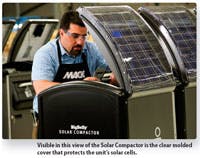Molded panel lets solar-powered trash compactor catch rays
Resources: |
The design of a solar-powered trash compactor for city streets used several plastic-molding issues to make it practical.
The original compactor made by BigBelly Solar in Needham, Mass., worked well but was costly to manufacture. The Mack Molding Co. in Arlington, Vt., worked with BigBelly to address the cost problems.
To shield the solar panel from the elements, Mack injection molds a clear cover from high-impact, UV-resistant polycarbonate resin on a 1,000-ton press. The large part must be perfectly clear to expose the solar panel below to the sun. The 27.75 × 20.39 × 4.39-in. part is molded with just one gate to avoid knit lines that would interfere with sunlight hitting the solar cells.
Mack conducted mold-flow analysis, as well as experiments with tooling, to set cycle time, temperature, and injection pressure. It finalized a mold that would give technicians more control over the process. The tool design was also critical in terms of the location and direction of water lines. Engineers were able to downsize the tool by using a hot runner bar, which lets the part run in a smaller press with better economics.
The trash bin in the compactor is rotomolded of low-density polyethylene resin. Mack fabricates the back panel and door out of metal. The unit can be custom painted, silk-screened with logos or other artwork, or vinyl wrapped with custom artwork.
Typical users of the trash bin include national parks, beaches, universities, towns, and major cities. The city of Philadelphia, for example, replaced 700 ordinary receptacles with 500 solar-powered trash compactors and 210 single-stream recycling units. The city now collects trash only five times per week instead of 17. Collection takes nine workers on one shift instead of 33 on three shifts, as was formerly the case.
About the Author
Leland Teschler
Lee Teschler served as Editor-in-Chief of Machine Design until 2014. He holds a B.S. Engineering from the University of Michigan; a B.S. Electrical Engineering from the University of Michigan; and an MBA from Cleveland State University. Prior to joining Penton, Lee worked as a Communications design engineer for the U.S. Government.


